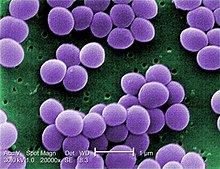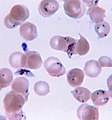Sophoraflavanone G

| |
| Names | |
|---|---|
| IUPAC name
(2S)-2-(2,4-dihydroxyphenyl)-5,7-dihydroxy-8-[(2R)-5-methyl-2-(prop-1-en-2-yl)hex-4-en-1-yl]-2,3-dihydro-4H-chromen-4-one
| |
| Identifiers | |
3D model (JSmol)
|
|
| ChEBI | |
| ChemSpider | |
PubChem CID
|
|
CompTox Dashboard (EPA)
|
|
| |
| |
| Properties | |
| C 25H 28O 6 | |
| Molar mass | 424.48622 g/mol |
| Hazards | |
| Occupational safety and health (OHS/OSH): | |
Main hazards
|
No known hazards |
Except where otherwise noted, data are given for materials in their standard state (at 25 °C [77 °F], 100 kPa).
| |
Sophoraflavanone G[1] is a volatile phytoncide, released into the atmosphere, soil and ground water, by members of the Sophora genus. Due to an increase in the rates of antibiotic-resistant bacteria, scientific efforts have focused on finding either naturally-made or genetically modified compounds that can treat and or prevent these harmful and sometimes deadly bacteria. Sophoraflavanone G, due to its use as a phytoncide, has been found to impact the growth of antibiotic-resistant bacteria and enhance the effect of currently used antibiotics.
Background information on phytoncides
1st discovered by B.P. Tokin, the word “phytoncide” literally means, exterminated by the plant. Phytoncides are a biologically active substance of plant origin that kills or inhibits growth and development of bacteria, microscopic fungi, and protozoa. Phytoncides play an important role in plant immunity and in the relationships between organisms within an ecosystem.[2]
The ability to produce phytoncides is a quality common among plants. The release of phytoncides increase when a plant is injured. Phytoncide compound composition's vary depending on whether the compound is considered a glycoside, terpenoid, or other secondary metabolites (not found in the major classes of natural compounds).[3]
Categories of phytoncides
There are two categories of phytoncides: 1) Nonexcretory phytoncides (found in the protoplasma of cells) and 2) Volatile phytoncides (released into the atmosphere, soil and water) Examples of plants releasing each type of phytoncide are: (nonexcretory)onion, garlic, and horseradish,and (volatile) pine, oak, eucalyptus, and members of the Sophora genus.[3]

Some phytoncides effect only insects feeding on the plant, acting on the insect’s autonomic nervous system. Other phytoncides target mainly microbes. The antimicrobial potency and range of phytoncides vary greatly among species. Some can kill many types of protozoa, bacteria, fungi, and insects within minutes or seconds, while others may take hours or only harm the pest. In addition to acting as a “plant protector”, phytoncides can also impede the reproduction of pests.[3]
General effect on environment
Regarding how phytoncides effect a plant’s immunity, for example, 1 hectare of pine forest will release approximately 5 kg of volatile phytoncides into the atmosphere in one day, reducing the amount of microflora in the air and essentially sterilizing the atmosphere among the forest, containing only about 200-300 bacterial cells/m3. This effect is found more commonly in coniferous forests as opposed to deciduous; something to consider when planning resort locations and urban landscaping.[3]
General uses of phytoncides
Because of the antimicrobial properties of phytoncides, extensive research has been done to investigate their use in medicine, as a plant protector in greenhouses, and in the shipping and storing of perishables like fruits and vegetables.
One volatile phytoncide, sophoraflavanone G, is of particular interest, due to its use in treating methicillin-resistant staphylococcus aureus and vancomycin-resistant enterococci bacteria.
Sophoraflavanone G

Sophoraflavanone G is among the volatile category of phytoncides, released into the atmosphere, soil, and ground water by the plant species Sophora flavescens,[4] Sophora pachycarpa, and Sophora exigua; all found to grow within the United States in a variety of soil types, within temperate conditions, no lower than 0°F (US zone 6 - yellow areas shown to the right). Sophoraflavanone G is released in order to protect the plant against harmful protozoa, bacteria, and fungi. Sophoraflavanone G, also called kushenin (in traditional Chinese medicinal recipes), is a flavonoid compound.
Flavanoids
Flavonoids are a class of secondary metabolites found in plants that fulfill a wide variety of functions. They are most commonly known as plant pigments in flower petals to attract pollinators and for their antioxidant activities, providing some hope for consumers regarding medicinal uses, potentially cancer treatment. It has not been until recently that their use as a phytoncide was made known.[5]
Toxicity
No known toxicity reports against humans have been found related to phytoncides, including Sophoraflavanone G.
Uses of Sophoraflavanone G: antimicrobial agent against MRSA and VRE
In result to the increasing cases of MRSA and VRE, a tremendous amount of research has gone into finding reliable methods of controlling and potentially preventing antibiotic-resistant strains of bacteria. One promising candidate for the treatment of these deadly bacteria is sophoraflavanone G. Throughout the scientific literature, it has been cited that sophoraflavanone G has had considerable success against antibiotic-resistant bacteria like S. aureus and Enterococci.
Staphylococcus aureus and Enterococcus are two of the leading causes of nosocomial (contracted while in a health facility) infections in hospitals and nursing homes, and reports on methicillin-resistant staphylococcus aureus (MRSA) and vancomycin-resistant enterococci (VRE) in hospitals have increased worldwide.


MRSA involves a strain of Staphylococcus aureus bacteria that normally lives on the skin and sometimes in the nasal passages of healthy people. In addition, these particular strains of S. aureus do not respond to some of the antibiotics used to treat staph infections. The bacteria can cause infection when they enter the body through a cut, sore, catheter, or breathing tube. Once infected, the case can be minor and local, or more serious, involving complications with the major tissues within the patient, specifically heart, lungs, blood, and bone. Serious staph infections are more common in people with weak immune systems, particularly patients in hospitals and long-term healthcare facilities and those who are healthy, but otherwise in close contact with many individuals through shared use of equipment and personal items, like athletes and children in daycare.[6]
Serious staph infections are quite difficult to treat, due to increasing numbers of antibiotic-resistant strains of S. aureus in the population. If left untreated, serious staph infections can result in organ failure and death.[6]
Enterococcus are normally present in the human intestines, female genital tract and often within the environment. When these bacteria cause infections, usually within the urinary tract, bloodstream, or in wounds associated with catheters or surgical procedures, the common antibiotic used to treat these cases is Vancomycin. In some instances, enterococci have become resistant to this drug and are, in result, referred to as vancomycin-resistant enterococci (VRE). Most of these infections occur within the long-term healthcare setting.[7]
Serious VRE infections are common among those who have been previously treated with the antibiotic vancomycin and hospitalized for long periods of time, those who have a weak immune system, any patients who have recently undergone surgery or those individuals with medical devices that stay inside their bodies for long periods of time (mainly catheters). VRE is often spread by the contaminated hands of caregivers, or directly after those infected with VRE, touch surfaces. VRE is not spread through the air by coughing or sneezing.[7]
Research into antimicrobial activity of Sophoraflavanone G
Research conducted in Japan, in 1995, report that the use of sophoraflavanone G completely inhibits the growth of 21 strains of methicillin-resistant S. aureus at concentrations of 3.13-6.25 ug/mL. When this compound is combined with vancomycin, minocycline, and rifampicin, the rates of inhibition increased, indicating a partially synergistic effect with anti-MRSA antibiotics (Sato et al.).[8] Similarly in Iran, in 2006, a research group reported that the antibacterial activity of gentamycin was enhanced through the use of sophoraflavanone G, citing that bacterial colonies of Staphylococcus aureus, on TLC plates showed significant decrease (4x) in growth while in the presence of small amounts (.03 ug/mL) of this compound (Fakhimi et al.).[9] Additional studies, done in South Korea in 2009 and Romania in 2010, support these findings of partially synergistic effects between sophoraflavanone G and various antibiotics, adding that when used either alone, or in conjunction with ampicillin and oxacillin (Cha et al.),[10] and ampicillin, gentamycin, minocycline, vancomycin, and hydrochloride (Duka et al.), sophoraflavanone G increases the number of antibiotic-resistant bacteria (MRSA & VRE) killed within plated colonies (based on FIC indices).
Additional uses of Sophoraflavanone G
In addition to the use of sophoraflavanone G as treatment against bacteria and other microflora present within the environment, by plants and humans alike, this compound has also been reported to be useful in the treatment of a variety of maladies, ranging from Eicosanoid-related skin inflammation such as atopic dermatitis, to treating more serious medical issues like malaria and myeloid leukemia.
Gallery
-
Plasmodium sporozoite traverses the cytoplasm of a mosquito midgut epithelial cell
-
Plasmodium within blood after contraction of malaria
-
Acute myeloid leukemia, showing characteristic growth of abnormal white blood cells
-
A child with atopic dermatitis
Regarding anti-inflammatory treatments, research by Kim et al. (2002) reported that sophoraflavanone G inhibited eicosanoid generating enzymes, and prostaglandin production, suggesting its potential use for eicosanoid-related skin inflammation such as atopic dermatitis.[11] In 2004, Youn et al. reported that sophoraflavanone G (in addition to other flavanoids) showed moderate anti-malarial activities based on the EC50 values within mice populations, potentially due to methoxyl groups found within the structure.[12] In addition, sophoraflavanone G has also been said to have implications for the treatment of myeloid leukemia, based on the research findings of Kang et al. (2000), who reported that sophoraflavanone G exhibited cytotoxic activity against human myeloid leukemia HL-60 cells.[13]
References
- ^ "Sophoraflavanone G." European Bioinformatics Institute. 17 October 2009.
- ^ "Phytoncide". The Great Soviet Encyclopedia, 3rd Edition (1970-1979).
- ^ a b c d Duka, R., and Ardelean, D. “Phytoncides and Phytoalexins – Vegetal Antibiotics.” Jurnal Medical Aradean (Arad Medical Journal) 13 (2010): 19-25.
- ^ Sophora flavescens (5 February 2011)
- ^ Flavonoids (8 April 2011)
- ^ a b "Methicillin-resistant Staphylococcus aureus; Community-acquired MRSA (CA-MRSA); Hospital-acquired MRSA (HA-MRSA)". National Institute of Health. 30 May 2009.
- ^ a b "Healthcare-associated infections". Centers for Disease Control and Prevention. 24 November 2010.
- ^ Sato, M., Tsuchiya, H., Takase, I., Kureshiro, H., Tanigaki, S. and Iinuma, M. “Antibacterial activity of flavanone isolated from Sophora exigua against methicillin-resistant Staphylococcus aureus and its combination with antibiotics.” Phytotherapy Research 9 (1995): 509–512.
- ^ Fakhimi A, Iranshahi M, Emami SA, Amin-Ar-Ramimeh E, Zarrini G, Shahverdi AR. “Sophoraflavanone G from sophora pachycarpa enhanced the antibacterial activity of gentamycin against Staphylococcus aureus.” Zeitschrift fur Naturforschung C. (Journal of Biosciences) Sep-Oct(9-10) 2006:769-72
- ^ Cha J., Moon S., Kim J., Jung E., Lee Y. “Antibacterial activity of sophoraflavanone G isolated from the roots of sophora flavescens against methicillin-resistant staphylococcus aureus.” Phytotherapy Research 23 Sep(9) 2009: 1326-31.
- ^ Kim D., Chi Y., Son K., Chang H., Kim J., Kang S., and Kim H. “Effects of sophoraflavanone G, a prenylated flavonoid from Sophora flavescens on cyclooxygenase-2 and in vivo inflammatory response.” Archives of Pharmacal Research Jun 25(3) 2002:329-35.
- ^ Youn Chul Kim, Hye-Sook Kim, Yusuke Wataya, Dong Hwan Sohn, Tai Hyun Kang, Myung Soo Kim, Yong Man Kim, Geon-Mok Lee, Jong-Duk Chang and Hyun Park, “Antimalarial Activity of Lavandulyl Flavanones Isolated from the Roots of Sophora flavescens”, Biological & Pharmaceutical Bulletin 27 (2004): 748-750.
- ^ Tai-Hyun Kang, Sei-Joon Jeong, Won-Gil Ko, Na-Young Kim, Byung-Hoon Lee, Masanori Inagaki, Tomofumi Miyamoto, Ryuichi Higuchi, and Youn-Chul Kim. “Cytotoxic Lavandulyl Flavanones from Sophora flavescens.” Journal of Natural Products 5 (2000):680–681.




